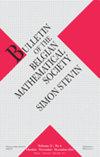超尺度开盘上解析函数的生长及其分支值
IF 0.6
4区 数学
Q4 MATHEMATICS
Bulletin of the Belgian Mathematical Society-Simon Stevin
Pub Date : 2021-12-01
DOI:10.36045/j.bbms.200707
引用次数: 0
摘要
设D为完全超度量代数闭场IK的开单位盘|x| < R。我们定义订单增长ρ(f),增长类型σ(f)和共型ψ(f)解析函数的D,我们表明,表示通过q (f, r)的数量为零的f x磁盘| |≤r和f将| | (r) =一口| x |≤r f (x) | |的下确界θ(f)的年代,lim→r−q (f, r)(−r) = 0满足θ(f)−1≤ρ(f)≤θ(f)和下确界的年代,lim→r−日志(f | | (r))(−r) = 0 =ρ(f)。此外,如果0 <ρ(f) < +∞和0 <ψ(f) < +∞,然后θ(f) =ρ(f)和σ(f) = 0。在零残留特点,然后ρ(f ') =ρ(f),σ(f ') =σ(f),ψ(f ') =ψ(f)。假设IK的特征为零。考虑两个无界解析函数f, g在d中,如果ρ(f) 6= ρ(g),则f至多有两个完美分支值,如果ρ(f) = ρ(g)但σ(f) 6= σ(g),则f至多有三个完美分支值;如果2σ(g) < σ(f),则g最多有两个完全分支值。学科分类:12J25;30 d35;30 g06本文章由计算机程序翻译,如有差异,请以英文原文为准。
Growth of analytic functions in an ultrametric open disk and branched values
Let D be the open unit disk |x| < R of a complete ultrametric algebraically closed field IK. We define the growth order ρ(f), the growth type σ(f) and the cotype ψ(f) of an analytic function in D and we show that, denoting by q(f, r) the number of zeros of f in the disk |x| ≤ r and putting |f |(r) = sup|x|≤r |f(x)|, the infimum θ(f) of the s such that lim r→R− q(f, r)(R− r) = 0 satisfies θ(f) − 1 ≤ ρ(f) ≤ θ(f) and the infimum of the s such that lim r→R− log(|f |(r))(R− r) = 0 is equal to ρ(f). Moreover, if 0 < ρ(f) < +∞ and 0 < ψ(f) < +∞, then θ(f) = ρ(f) and σ(f) = 0. In residue characteristic zero, then ρ(f ′) = ρ(f), σ(f ′) = σ(f), ψ(f ′) = ψ(f). Suppose IK has characteristic zero. Consider two unbounded analytic functions f, g in D. If ρ(f) 6= ρ(g), then f g has at most two perfectly branched values and if ρ(f) = ρ(g) but σ(f) 6= σ(g), then f g has at most three perfectly branched values; moreover, if 2σ(g) < σ(f), then f g has at most two perfectly branched values. Subject Classification: 12J25; 30D35; 30G06
求助全文
通过发布文献求助,成功后即可免费获取论文全文。
去求助
来源期刊
CiteScore
1.00
自引率
0.00%
发文量
14
审稿时长
6-12 weeks
期刊介绍:
The Bulletin of the Belgian Mathematical Society - Simon Stevin (BBMS) is a peer-reviewed journal devoted to recent developments in all areas in pure and applied mathematics. It is published as one yearly volume, containing five issues.
The main focus lies on high level original research papers. They should aim to a broader mathematical audience in the sense that a well-written introduction is attractive to mathematicians outside the circle of experts in the subject, bringing motivation, background information, history and philosophy. The content has to be substantial enough: short one-small-result papers will not be taken into account in general, unless there are some particular arguments motivating publication, like an original point of view, a new short proof of a famous result etc.
The BBMS also publishes expository papers that bring the state of the art of a current mainstream topic in mathematics. Here it is even more important that at leat a substantial part of the paper is accessible to a broader audience of mathematicians.
The BBMS publishes papers in English, Dutch, French and German. All papers should have an abstract in English.

 求助内容:
求助内容: 应助结果提醒方式:
应助结果提醒方式:


